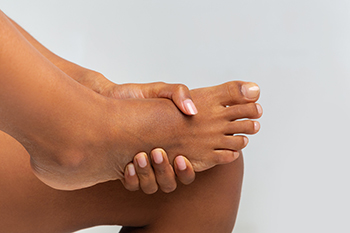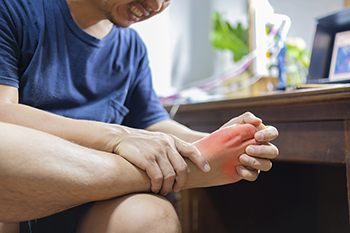Items filtered by date: August 2022
Causes of Tarsal Tunnel Syndrome

The medical term for the foot condition known as tarsal tunnel syndrome is posterior tibial neuralgia. It can cause severe pain and discomfort as a result of a compressed tibial nerve as it travels through the tarsal tunnel. Patients who experience this ailment may have a predisposition to diabetes, alcoholism, or specific types of neuropathies. The symptoms that are often associated with tarsal tunnel syndrome consist of tenderness surrounding the ankle, a lack of feeling in the sole, and difficulty walking or standing. It may be a frequent ailment among people who have flat feet, and the fallen arch may begin to compress the nerve. Additionally, if a foot injury has occurred, it may damage the tarsal tunnel and the nerve that is inside it. If you have any of the above symptoms, it is suggested that you have a physical examination from a podiatrist who can accurately diagnose and treat this condition.
Tarsal tunnel syndrome can be very uncomfortable to live with. If you are experiencing tarsal tunnel syndrome, contact one of our podiatrists of CyFair Family Foot Care. Our doctors can provide the care you need to keep you pain-free and on your feet.
Tarsal Tunnel Syndrome
Tarsal tunnel syndrome, which can also be called tibial nerve dysfunction, is an uncommon condition of misfiring peripheral nerves in the foot. The tibial nerve is the peripheral nerve in the leg responsible for sensation and movement of the foot and calf muscles. In tarsal tunnel syndrome, the tibial nerve is damaged, causing problems with movement and feeling in the foot of the affected leg.
Common Cause of Tarsal Tunnel Syndrome
- Involves pressure or an injury, direct pressure on the tibial nerve for an extended period of time, sometimes caused by other body structures close by or near the knee.
- Diseases that damage nerves, including diabetes, may cause tarsal tunnel syndrome.
- At times, tarsal tunnel syndrome can appear without an obvious cause in some cases.
The Effects of Tarsal Tunnel Syndrome
- Different sensations, an afflicted person may experience pain, tingling, burning or other unusual sensations in the foot of the affected leg.
- The foot muscles, toes and ankle become weaker, and curling your toes or flexing your foot can become difficult.
- If condition worsens, infections and ulcers may develop on the foot that is experiencing the syndrome.
A physical exam of the leg can help identify the presence of tarsal tunnel syndrome. Medical tests, such as a nerve biopsy, are also used to diagnose the condition. Patients may receive physical therapy and prescriptive medication. In extreme cases, some may require surgery.
If you have any questions please feel free to contact our offices located in Cypress and Spring, TX . We offer the newest diagnostic and treatment technologies for all your foot and ankle needs.
It's Time for Beautiful Feet
Causes of Crooked Toes

Some people are born with crooked toes, and others acquire them over time. Common types of crooked toes are curly toes, hammertoe, mallet toe, claw toe, overlapping toe, and adductovarus toe. Curly toes are generally congenital, where the third or fourth toe of the foot curls under the foot. A hammertoe has an imbalance in the ligaments, tendons, and muscles of the toe, causing the middle joint to pop up. In a mallet toe, the joint closest to the toenail pops up and curls under the foot. It may result from wearing shoes that are too tight or shoes with high heels. Claw toes bend under the foot, and may even dig into the sole of the foot. Aside from being painful, they can cause corns and calluses to form. An overlapping toe sits on top of the toe next to it. This may cause pain when wearing closed shoes and inhibit walking. An adductovarus toe tries to move beneath the toe next to it. This is more common in the fourth or fifth toe and can be a direct result of wearing shoes with a pointy toe box. If you have any of these toe deformities that are causing pain or inhibiting your daily activities, it is a good idea to consult with a podiatrist for treatment options.
Toe pain can disrupt your daily activities. If you have any concerns, contact one of our podiatrists of CyFair Family Foot Care. Our doctors can provide the care you need to keep you pain-free and on your feet.
What Causes Toe Pain?
Most severe toe pain is caused due to a sports injury, trauma from dropping something heavy on the toe, or bumping into something rigid. Other problems can develop over time for various reasons.
Toe pain can be caused by one or more ailments. The most common include:
- Trauma
- Sports injury
- Wearing shoes that are too tight
- Arthritis
- Gout
- Corns and calluses
- Hammertoe
- Bunions
- Blisters
- Ingrown toenails
- Sprains
- Fractures (broken bones)
- Dislocations
When to See a Podiatrist
- Severe pain
- Persistent pain that lasts more than a week
- Signs of infection
- Continued swelling
- Pain that prevents walking
Diagnosis
In many cases the cause of toe pain is obvious, but in others, a podiatrist may want to use more advanced methods to determine the problem. These can range from simple visual inspections and sensation tests to X-rays and MRI scans. Prior medical history, family medical history, and any recent physical traumatic events will all be taken into consideration for a proper diagnosis.
Treatment
Treatments for toe pain and injuries vary and may include shoe inserts, padding, taping, medicines, injections, and in some cases, surgery. If you believe that you have broken a toe, please see a podiatrist as soon as possible.
If you have any questions please feel free to contact our offices located in Cypress and Spring, TX . We offer the newest diagnostic tools and technology to treat your foot and ankle needs.
What Does an Ankle Sprain Feel Like?

Spraining your ankle is certainly not a pleasant experience. Not only can ankle sprains be painful, they can also take weeks to months to fully heal, depending on the severity of the sprain. Ankle sprains occur when the ligaments surrounding the ankle bones and joints become torn, stressed, or otherwise strained. If you suspect that you might have sprained your ankle, here are several symptoms that some patients might experience with an ankle sprain. First, an individual might be unable to put their weight on the affected ankle, and be incapable of walking or running. If you have an ankle sprain, you might also notice some degree of skin discoloration on the affected area or perhaps some bruising. You might even experience different sensations in the ankle, such as a feeling of swelling, tenderness, or stiffness. Ankle sprains happen to many different people, so if you think that you might be one of them, contact a podiatrist. Your podiatrist will be able to help you remedy the problem.
Ankle sprains are common but need immediate attention. If you need your feet checked, contact one of our podiatrists from CyFair Family Foot Care. Our doctors can provide the care you need to keep you pain-free and on your feet.
How Does an Ankle Sprain Occur?
Ankle sprains take place when the ligaments in your ankle are torn or stretched beyond their limits. There are multiple ways that the ankle can become injured, including twisting or rolling over onto your ankle, putting undue stress on it, or causing trauma to the ankle itself.
What Are the Symptoms?
- Mild to moderate bruising
- Limited mobility
- Swelling
- Discoloration of the skin (depending on severity)
Preventing a Sprain
- Wearing appropriate shoes for the occasion
- Stretching before exercises and sports
- Knowing your limits
Treatment of a Sprain
Treatment of a sprain depends on the severity. Many times, people are told to rest and remain off their feet completely, while others are given an air cast. If the sprain is very severe, surgery may be required.
If you have suffered an ankle sprain previously, you may want to consider additional support such as a brace and regular exercises to strengthen the ankle.
If you have any questions please feel free to contact our offices located in Cypress and Spring, TX . We offer the newest diagnostic and treatment technologies for all your foot and ankle needs.
Toe Arthritis Is Common

Many people have arthritis in various joints of the body, and this often includes the toes. It can happen as a result of cartilage that has been worn away causing the bones in the toes to rub together. This can produce severe pain and discomfort and generally happens to the big toe. There are various reasons why arthritis in the toes occurs including genetic history, being overweight, and increased age. Additionally, women who frequently wear high heels may be at risk to develop this type of arthritis, so it is suggested that flat shoes are alternated with high heels. The first symptom to accompany arthritis is pain. Patients often describe it as an ache that develops gradually, or it may feel like a stabbing sensation. Additional symptoms may include stiffness or swelling, and there can be a clicking noise. As arthritis develops, it may become difficult to walk and may feel better when the affected foot is elevated. If you have arthritis in your toes, it is strongly advised that you consult with a podiatrist who can guide you toward proper treatment techniques.
Arthritis can be a difficult condition to live with. If you are seeking treatment, contact one of our podiatrists from CyFair Family Foot Care. Our doctors can provide the care you need to keep you pain-free and on your feet.
Arthritic Foot Care
Arthritis is a term that is commonly used to describe joint pain. The condition itself can occur to anyone of any age, race, or gender, and there are over 100 types of it. Nevertheless, arthritis is more commonly found in women compared to men, and it is also more prevalent in those who are overweight. The causes of arthritis vary depending on which type of arthritis you have. Osteoarthritis for example, is often caused by injury, while rheumatoid arthritis is caused by a misdirected immune system.
Symptoms
- Swelling
- Pain
- Stiffness
- Decreased Range of Motion
Arthritic symptoms range in severity, and they may come and go. Some symptoms stay the same for several years but could potentially get worse with time. Severe cases of arthritis can prevent its sufferers from performing daily activities and make walking difficult.
Risk Factors
- Occupation – Occupations requiring repetitive knee movements have been linked to osteoarthritis
- Obesity – Excess weight can contribute to osteoarthritis development
- Infection – Microbial agents can infect the joints and trigger arthritis
- Joint Injuries – Damage to joints may lead to osteoarthritis
- Age – Risk increases with age
- Gender –Most types are more common in women
- Genetics – Arthritis can be hereditary
If you suspect your arthritis is affecting your feet, it is crucial that you see a podiatrist immediately. Your doctor will be able to address your specific case and help you decide which treatment method is best for you.
If you have any questions, please feel free to contact our offices located in Cypress and Spring, TX . We offer the newest diagnostic and treatment technologies for all your foot care needs.
What Is Gout and How Can It Be Prevented?

A common condition that affects the feet is known as gout. It falls into the arthritis category, and can cause severe pain and discomfort. It develops as a result of elevated uric acid levels in the blood, and this can cause crystals to form in the joints of the big toe, as well as other joints. Causes are varied, including being overweight, eating excessive red meat and shellfish, and consuming drinks that are made with large amounts of sugar. Additionally, existing medical conditions, such as congestive heart failure, diabetes, and poor kidney function may lead to developing gout. The symptoms that are often associated with this condition may include swelling, intense pain, redness, and the affected area may feel hot when touched. Gout is often diagnosed during a flare up, and a needle may be inserted into the affected joint that can provide a sample of the crystals. Effective prevention strategies of gout can consist of eating a healthy diet, getting and staying physically active, and managing weight. If you have gout attacks, it is suggested that you speak with a podiatrist who can provide you with correct treatment and preventive techniques.
Gout is a painful condition that can be treated. If you are seeking treatment, contact one of our podiatrists from CyFair Family Foot Care. Our doctors will treat your foot and ankle needs.
What Is Gout?
Gout is a form of arthritis that is characterized by sudden, severe attacks of pain, redness, and tenderness in the joints. The condition usually affects the joint at the base of the big toe. A gout attack can occur at any random time, such as the middle of the night while you are asleep.
Symptoms
- Intense Joint Pain - Usually around the large joint of your big toe, and it most severe within the first four to twelve hours
- Lingering Discomfort - Joint discomfort may last from a few days to a few weeks
- Inflammation and Redness -Affected joints may become swollen, tender, warm and red
- Limited Range of Motion - May experience a decrease in joint mobility
Risk Factors
- Genetics - If family members have gout, you’re more likely to have it
- Medications - Diuretic medications can raise uric acid levels
- Gender/Age - Gout is more common in men until the age of 60. It is believed that estrogen protects women until that point
- Diet - Eating red meat and shellfish increases your risk
- Alcohol - Having more than two alcoholic drinks per day increases your risk
- Obesity - Obese people are at a higher risk for gout
Prior to visiting your podiatrist to receive treatment for gout, there are a few things you should do beforehand. If you have gout you should write down your symptoms--including when they started and how often you experience them, important medical information you may have, and any questions you may have. Writing down these three things will help your podiatrist in assessing your specific situation so that he or she may provide the best route of treatment for you.
If you have any questions, please feel free to contact our offices located in Cypress and Spring, TX . We offer the newest diagnostic and treatment technologies for all your foot care needs.

